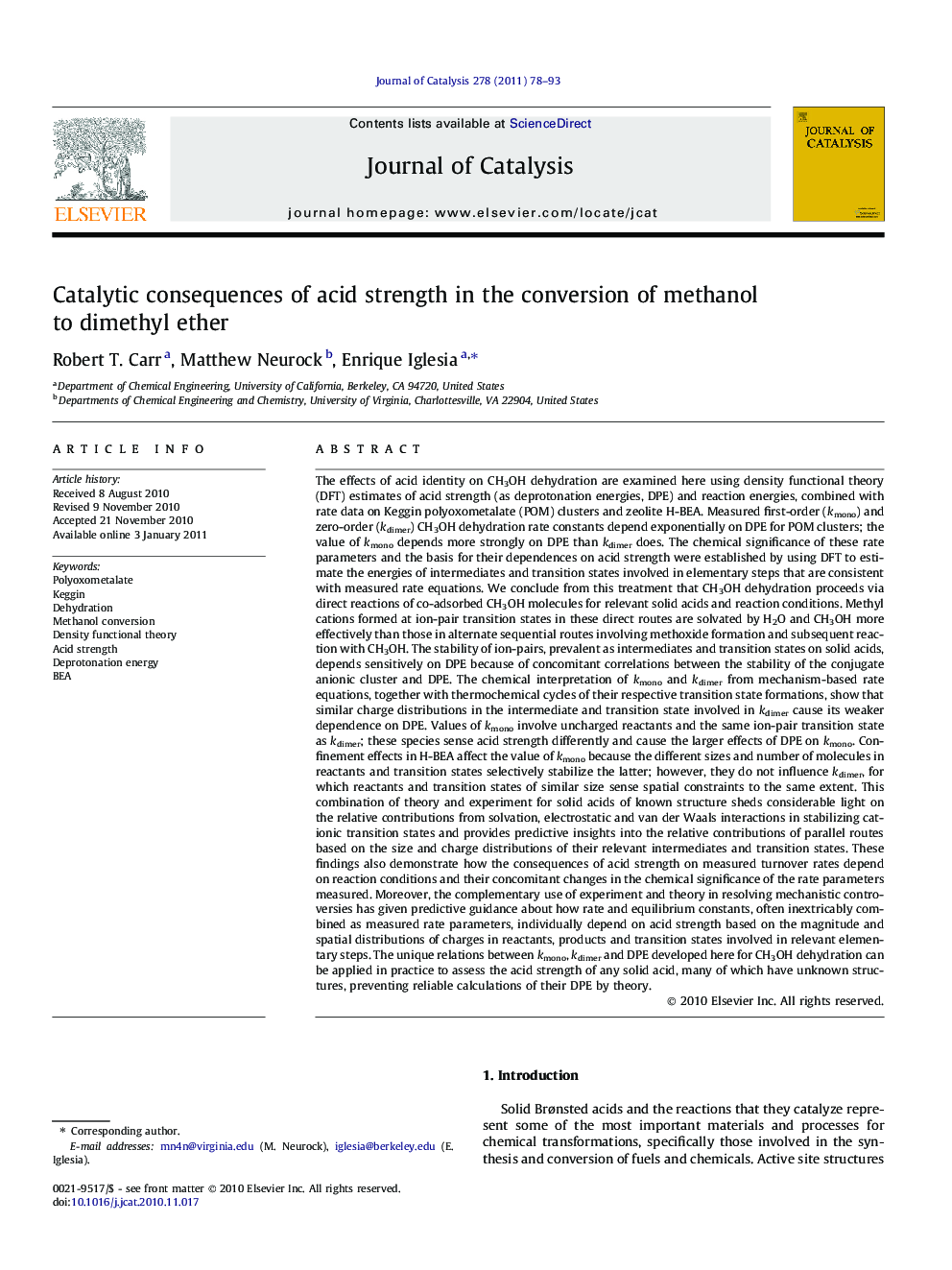| کد مقاله | کد نشریه | سال انتشار | مقاله انگلیسی | نسخه تمام متن |
|---|---|---|---|---|
| 61911 | 47612 | 2011 | 16 صفحه PDF | دانلود رایگان |

The effects of acid identity on CH3OH dehydration are examined here using density functional theory (DFT) estimates of acid strength (as deprotonation energies, DPE) and reaction energies, combined with rate data on Keggin polyoxometalate (POM) clusters and zeolite H-BEA. Measured first-order (kmono) and zero-order (kdimer) CH3OH dehydration rate constants depend exponentially on DPE for POM clusters; the value of kmono depends more strongly on DPE than kdimer does. The chemical significance of these rate parameters and the basis for their dependences on acid strength were established by using DFT to estimate the energies of intermediates and transition states involved in elementary steps that are consistent with measured rate equations. We conclude from this treatment that CH3OH dehydration proceeds via direct reactions of co-adsorbed CH3OH molecules for relevant solid acids and reaction conditions. Methyl cations formed at ion-pair transition states in these direct routes are solvated by H2O and CH3OH more effectively than those in alternate sequential routes involving methoxide formation and subsequent reaction with CH3OH. The stability of ion-pairs, prevalent as intermediates and transition states on solid acids, depends sensitively on DPE because of concomitant correlations between the stability of the conjugate anionic cluster and DPE. The chemical interpretation of kmono and kdimer from mechanism-based rate equations, together with thermochemical cycles of their respective transition state formations, show that similar charge distributions in the intermediate and transition state involved in kdimer cause its weaker dependence on DPE. Values of kmono involve uncharged reactants and the same ion-pair transition state as kdimer; these species sense acid strength differently and cause the larger effects of DPE on kmono. Confinement effects in H-BEA affect the value of kmono because the different sizes and number of molecules in reactants and transition states selectively stabilize the latter; however, they do not influence kdimer, for which reactants and transition states of similar size sense spatial constraints to the same extent. This combination of theory and experiment for solid acids of known structure sheds considerable light on the relative contributions from solvation, electrostatic and van der Waals interactions in stabilizing cationic transition states and provides predictive insights into the relative contributions of parallel routes based on the size and charge distributions of their relevant intermediates and transition states. These findings also demonstrate how the consequences of acid strength on measured turnover rates depend on reaction conditions and their concomitant changes in the chemical significance of the rate parameters measured. Moreover, the complementary use of experiment and theory in resolving mechanistic controversies has given predictive guidance about how rate and equilibrium constants, often inextricably combined as measured rate parameters, individually depend on acid strength based on the magnitude and spatial distributions of charges in reactants, products and transition states involved in relevant elementary steps. The unique relations between kmono, kdimer and DPE developed here for CH3OH dehydration can be applied in practice to assess the acid strength of any solid acid, many of which have unknown structures, preventing reliable calculations of their DPE by theory.
Dimethyl ether synthesis on solid acids occurs via direct reactions of two co-adsorbed CH3OH molecules because methyl cations at transition states are effectively solvated by H2O and CH3OH molecules. On acids, activation barriers and their sensitivity to acid strength depend on differences in charge distribution and density in adsorbed reactants and their respective transition states.Figure optionsDownload high-quality image (98 K)Download as PowerPoint slideResearch highlights
► CH3OH conversion to dimethyl ether on polyoxometalate and zeolite solid acids.
► Mechanism discrimination by combined kinetic and density functional theory analyses.
► Reaction sensitivity to acid strength determination by structure–function relations.
Journal: Journal of Catalysis - Volume 278, Issue 1, 14 February 2011, Pages 78–93